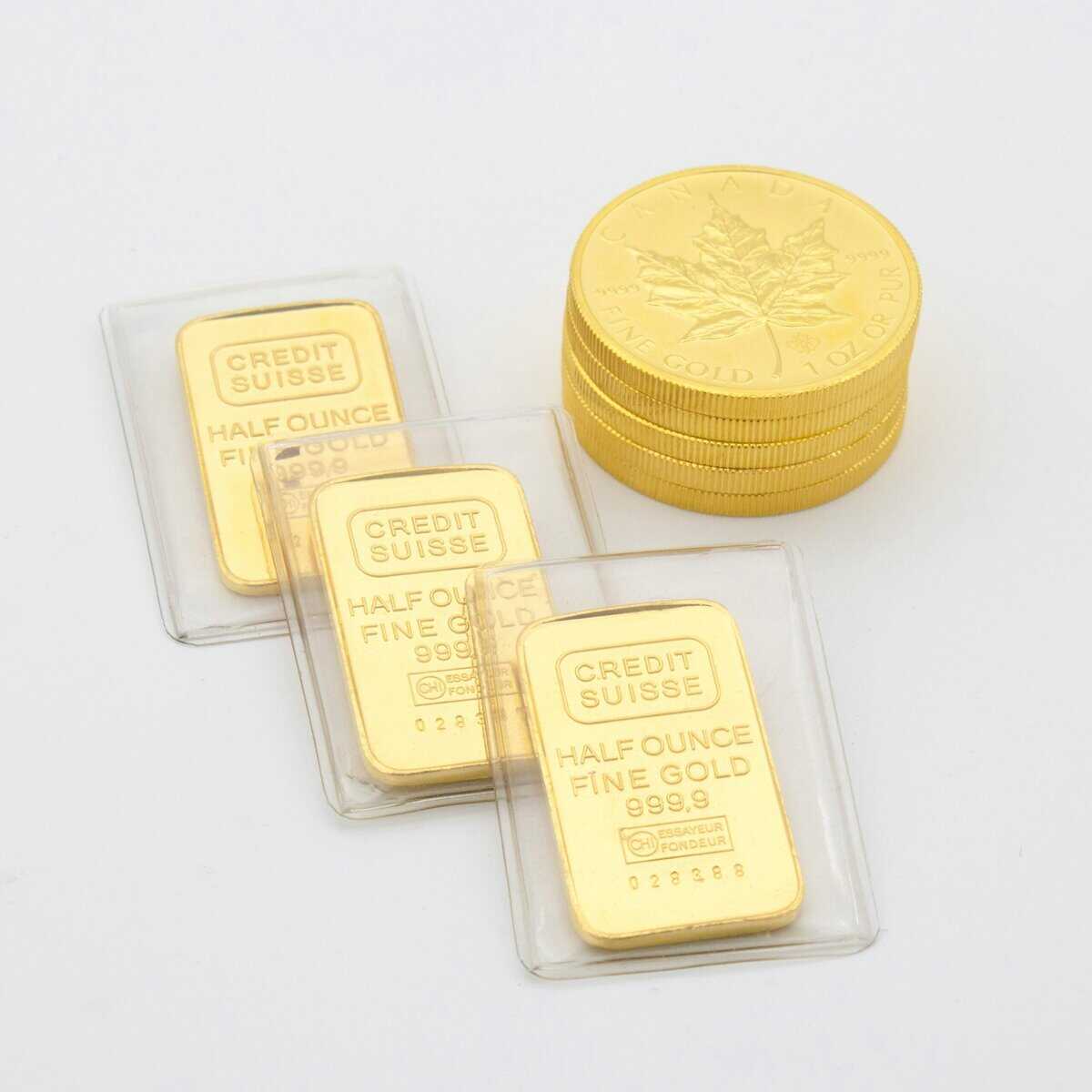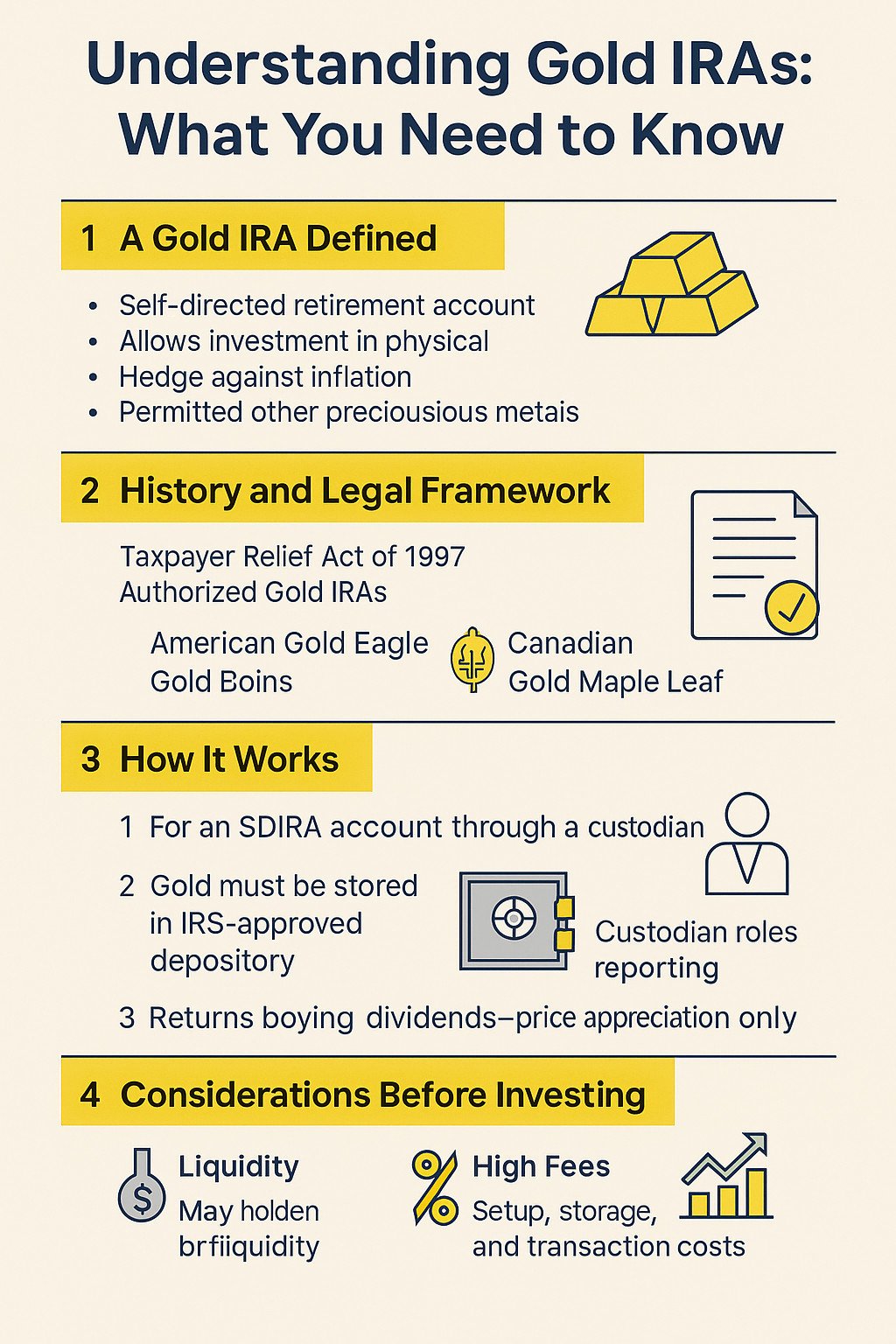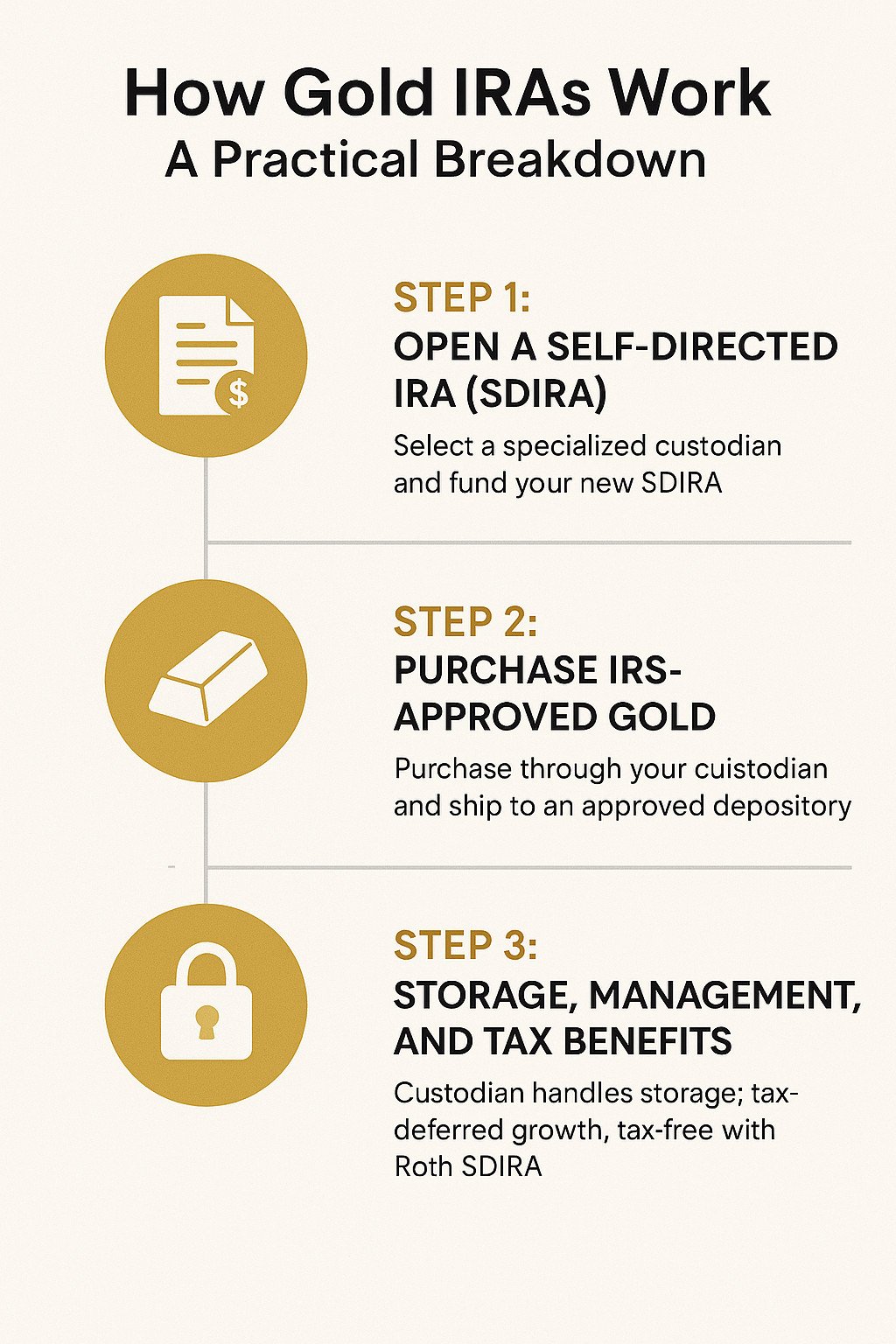Ultimate Gold IRA Guide: How to Invest in Gold During Inflation

Inflation erodes purchasing power and adds uncertainty to long-term savings. What happens in times like these, is that investors often turn to gold, which is a proven store of value during economic stress.
But owning gold in your retirement account isn’t as simple as buying coins or bullion.
For this reason, this gold IRA guide explains how to invest in physical gold through a self-directed IRA.
You'll learn what a gold IRA is, how it works, and which strategies help protect your retirement portfolio from inflation.
This is the reason why we wrote this guide to walk you through the essentials, step by step. Let's see together the key takeaways of this article before getting in :

Key Takeaways:
- Why gold is a powerful hedge against inflation and currency devaluation
- How to set up a self-directed Gold IRA with the right custodian and storage
- Tax advantages of Gold IRAs (Traditional vs Roth) and IRS compliance rules
- Gold IRA pros and cons in volatile or inflationary economic cycles
- Real historical data proving gold’s resilience in times of crisis
- Actionable tips to evaluate if a Gold IRA fits your long-term retirement strategy
Understanding Gold IRAs: What You Need to Know
A Gold IRA is a type of self-directed individual retirement account that allows you to invest in physical gold and, in some cases, other IRS-approved precious metals like silver, platinum, and palladium.
Contrary to traditional IRAs that hold paper assets such as stocks, ETFs, or mutual funds, a gold IRA gives you the ability to own tangible, real-world assets within your retirement portfolio.
As a result, this investment structure appeals to those looking to hedge against inflation, currency devaluation, or systemic risk.
Gold has historically retained its value during market downturns, making it a popular choice during economic uncertainty.

A Brief History and Legal Framework
Gold IRAs became possible after the Taxpayer Relief Act of 1997, which authorized certain precious metals to be included in self-directed IRAs. However, the Internal Revenue Service (IRS) maintains strict standards regarding which forms of gold qualify.
Only bullion with a purity of at least 99.5% is allowed. This includes well-known products like:
- American Gold Eagle coins (despite being only 91.67% pure, they are explicitly approved),
- Canadian Gold Maple Leaf coins,
- Gold bars produced by refiners accredited by NYMEX or COMEX.
These rules are in place to ensure liquidity, authenticity, and valuation consistency.
How It Works: Custodians, Depositories, and Compliance
To open a gold IRA, you need to set up a self-directed IRA (SDIRA) through a specialized custodian. This custodian is not just a passive administrator; they are legally required to handle:
- Reporting to the IRS,
- Processing buy/sell orders,
- Verifying asset eligibility,
- Managing storage logistics.
You cannot store the gold at home or in a personal safe. The IRS mandates that all physical metals be held in an approved depository, such as Delaware Depository or Brink’s Global Services. These facilities provide insurance, security, and proper chain-of-custody documentation.
Considerations Before You Invest
While gold IRAs offer security, they also come with unique challenges:
- Liquidity can be lower than with traditional IRAs.
- Fees (setup, storage, custodian, transaction) are typically higher, because the process can be long and articulated.
- No dividends or interest—your returns depend solely on price appreciation and generally speaking, gold prices fluctuate less than stock products.
Still, for many investors, the non-correlation to stocks and fiat currencies makes gold a compelling component in a diversified retirement plan.
Why Gold Matters During Inflation
Inflation reduces the real value of money over time. As prices rise, each dollar buys less, leading to shrinking purchasing power and growing financial uncertainty. While traditional investments like stocks or bonds may lose ground during such periods, gold has historically acted as a counterweight.
In fact, Gold cannot be printed or manipulated by central banks, contrarily to paper assets. It's finite, universally valued, and decoupled from government policies, making it a natural hedge. During inflationary cycles, gold tends to appreciate, helping to offset losses in fiat-denominated assets.
A Proven Hedge: What History Tells Us
This isn’t just theory. During the 1970s, a decade marked by stagflation, the price of gold rose from $35/oz in 1971 to over $850/oz by 1980. More recently, between 2008 and 2011, in the aftermath of the financial crisis and the Fed’s QE policies, gold surged from around $800/oz to over $1,900/oz.
As a result, after integrating physical gold into a retirement account, investors add a layer of protection that can stabilize portfolio value when inflation eats into stocks, bonds, or savings accounts.
Why Hold Gold in an IRA?
A Gold IRA offers tax advantages while giving you exposure to an asset that resists inflation. While the value of paper assets may erode, gold has the potential to rise, protecting your retirement savings in real terms. Especially during inflationary cycles, this can make the difference between losing ground and staying ahead.
How Gold IRAs Work: A Practical Breakdown
A Gold IRA follows the same basic structure as a traditional IRA, but instead of holding mutual funds or ETFs, it contains physical precious metals. These can include IRS-approved gold coins and bullion, as well as silver, platinum, and palladium in some cases.
Here’s how it works, step by step.
Step 1: Open a Self-Directed IRA (SDIRA)
You’ll need to select a custodian that specializes in alternative assets like gold. This is not the same as a typical brokerage firm. These custodians are approved by the IRS and equipped to manage the legal and logistical aspects of physical metal storage.
You can fund your SDIRA via:
- Direct contributions (subject to annual limits—$7,000 if over 50),
- IRA-to-IRA transfers,
- 401(k) or 403(b) rollovers (tax-deferred if done correctly).

Step 2: Purchase IRS-Approved Gold
Once the account is funded, you’ll select the type of gold you want to hold. The IRS requires a minimum purity of 99.5% for gold bullion, though it explicitly allows certain coins like the American Gold Eagle (91.67%).
All metals must be purchased through your custodian and shipped directly to an IRS-approved depository, such as:
- Brink’s,
- Delaware Depository,
- International Depository Services Group.
Storing gold at home violates IRS rules and can trigger penalties.
Step 3: Storage, Management, and Tax Benefits
The custodian handles:
- Secure purchase transactions,
- Delivery logistics,
- Depository documentation,
- Annual IRS compliance reporting.
From a tax standpoint, Gold IRAs grow tax-deferred, just like traditional IRAs. You don’t pay taxes on gains until you take distributions. If you choose a Roth SDIRA structure, qualified withdrawals are completely tax-free.
Key Benefits of Gold IRAs in an Inflationary Economy
Gold IRAs provide a unique blend of stability, protection, and long-term growth potential, making them particularly valuable during periods of high inflation.
1. Hedge Against Inflation
One of the most cited benefits is gold's ability to preserve purchasing power. While inflation eats away at the value of fiat currency, the price of gold often rises. This inverse correlation means that gold can act as a stabilizer when the dollar weakens.
Cash or bonds can lose value in real terms during inflation. On the contrary, gold maintains its intrinsic worth. In fact, many investors consider it a “crisis asset”, capable of retaining value when other markets falter.
2. Diversification and Risk Reduction
Including gold in your IRA improves asset class diversification, which is a cornerstone of sound retirement planning. When stocks decline due to market shocks or central bank policy shifts, gold often remains resilient, or even appreciates.
Gold has also shown strength during:
- Geopolitical crises,
- Banking instability,
- Periods of stagflation (slow growth + high inflation).
Adding even a small allocation (5–15%) to gold can reduce overall portfolio volatility and smooth long-term returns.
3. Tax-Deferred Growth and Roth Advantages
Gold IRAs follow the same tax rules as traditional or Roth IRAs:
- Traditional Gold IRA: Contributions may be tax-deductible, and gains are tax-deferred.
- Roth Gold IRA: Contributions are made with after-tax income, but qualified withdrawals are entirely tax-free.
This structure allows investors to let their gold investment compound over decades, without being taxed annually on market gains. Over time, this can make a meaningful difference in retirement outcomes, especially if gold prices rise steadily.
4. Wealth Protection with Legal Clarity
All assets in a gold IRA are held under custodial management and insured within approved depositories. This adds a layer of legal and financial protection, ensuring that the metal is fully traceable, auditable, and compliant with IRS rules.
“
Case Study: David Einhorn’s Hedge Fund and Gold in 2025
Overview
In Q1 2025, billionaire investor David Einhorn’s firm, Greenlight Capital, demonstrated a remarkable success by allocating a significant portion of its portfolio to gold under Biden-era inflation concerns.
Results
- Greenlight returned +8.2% during the quarter, while the S&P 500 lost 4% overall.
- Gold was “by far the biggest winner”, appreciating approximately 19% in this period
Strategy & Timing
Greenlight executed purchases of physical gold and gold call options, anticipating rising inflation due to government fiscal policies. Simultaneously, they reduced exposure to equities as they expected a prolonged bear market, reinforcing a strategic pivot toward safer, inflation-resistant assets Gold IRA.
What It Shows
- Even in professional macro portfolios, gold can outperform during inflationary trends.
- Combining physical gold with derivatives (like call options) can amplify returns—suggesting a higher-risk but higher-return play.
- The case confirms that gold remains a reliable hedge when inflation and economic policy pressures mount.
Why It Matters for you?
If a hedge fund can generate alpha from gold exposure, imagine what a disciplined allocation can do for a retirement portfolio. While most individual investors won’t use complex derivatives, the underlying strategy holds: adding physical gold can offer real value and protection in uncertain times.
Tax Rules and Compliance: What You Need to Know
When investing in a Gold IRA, understanding the tax implications and IRS rules isn’t just helpful, it’s essential. One of the key benefits of a Gold IRA is tax-deferred growth: your investment can grow over time without triggering taxes until you take distributions.
If you opt for a Roth structure, qualified withdrawals in retirement are completely tax-free, offering even more long-term advantages.
That said, the IRS imposes strict requirements to ensure that Gold IRAs are used appropriately. Only gold with a purity of 99.5% or higher qualifies, and not every coin or bar makes the cut. Approved examples include:
- American Gold Eagle coins (an exception to the purity rule),
- Canadian Maple Leafs,
- Bullion bars from IRS-approved refiners.
Just as important: all gold must be stored in an IRS-approved depository. You can’t keep it at home, even in a personal safe; doing so could invalidate the IRA’s tax status and result in penalties.
When it comes time to take distributions, the same rules apply as with any traditional IRA:
- Withdrawals before age 59½ trigger a 10% early withdrawal penalty plus income tax.
- At age 73 (formerly 72), Required Minimum Distributions (RMDs) kick in and are taxed as ordinary income.
The bottom line? Work with a reputable custodian who understands the nuances of gold IRAs, and when in doubt, consult a tax advisor.
Planning can prevent costly mistakes and help you fully benefit from the tax advantages this vehicle offers.
Final Thoughts: Investing in Gold with Confidence
A Gold IRA isn’t a speculative play, it’s a long-term strategy rooted in caution, protection, and balance. In a world where markets shift rapidly, currencies lose value, and central banks move unpredictably, having a portion of your retirement anchored in gold can bring a level of stability that’s hard to find elsewhere.
But this isn’t a shortcut or a one-size-fits-all solution. To make it work, you need to:
- Understand the structure and mechanics,
- Choose the right custodian and depository,
- Stay informed about IRS rules and tax deadlines,
- View gold not as a silver bullet, but as a complement to a broader, diversified portfolio.
If you’re reading this guide, it means you’re already doing the most important thing: educating yourself. That alone puts you ahead of most investors.
check out our
Latest Articles...
Author

Ignazio Di Salvo
Founder
I have a background in Economics and Business Administration from Bocconi University and a formation in Digital Marketing. I am passionate about investments and I founded BestGoldMoney.com to help individuals make smarter decisions when investing in gold, silver, and other precious metals.
BestGoldMoney.Com
At Best Gold Money, we simplify the complexities of investing in precious metals. Our platform offers comprehensive insights, reviews, and reliable recommendations to help you make informed decisions about investments in precious metals.
We focus on providing valuable educational resources, expert analysis, and up-to-date information on the best practices for securing your financial future.
As part of our commitment to transparency, we participate in affiliate marketing programs, ensuring that we only endorse products and services we trust.